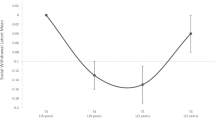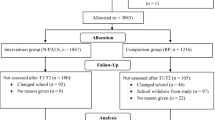Abstract
Heterogeneity and individual differences in the developmental course of social withdrawal were examined longitudinally in a community sample (N = 392). General Growth Mixture Modeling (GGMM) was used to identify distinct pathways of social withdrawal, differentiate valid subgroup trajectories, and examine factors that predicted change in trajectories within subgroups. Assessments of individual (social withdrawal), interactive (prosocial behavior), relationship (friendship involvement, stability and quality, best friend’s withdrawal and exclusion/victimization) and group- (exclusion/victimization) level characteristics were used to define growth trajectories from the final year of elementary school, across the transition to middle school, and then to the final year of middle school (fifth-to-eighth grades). Three distinct trajectory classes were identified: low stable, increasing, and decreasing. Peer exclusion, prosocial behavior, and mutual friendship involvement differentiated class membership. Friendlessness, friendship instability, and exclusion were significant predictors of social withdrawal for the increasing class, whereas lower levels of peer exclusion predicted a decrease in social withdrawal for the decreasing class.

Similar content being viewed by others
References
Akaike, H. (1987). Factor analysis and AIC. Psychometrika, 52, 317–332.
Arbuckle, J. (1996). Full information estimation in the presence of incomplete data. In G.A. Marcoulides, & R.E. Schumacker (Eds.) Advanced structural equation modeling. Mahwah, New Jersey: Lawrence Erlbaum Associates.
Asendorpf, J. (1993). Abnormal shyness in children. Journal of Child Psychology and Psychiatry, 34, 1069–1081.
Barber, B., & Olsen, J. (2004). Assessing the transitions to middle and high school. Journal of Adolescent Research, 19, 3–30.
Berndt, T., Hawkins, J., & Jiao, Z. (1999). Influences of friends and friendship on adjustment to junior high school. Merrill Palmer Quarterly, 45, 13–41.
Boivin, M., & Hymel, S. (1997). Peer experiences and social self-perceptions: a sequential model. Developmental Psychology, 33, 135–145.
Boivin, M., Hymel, S., & Bukowski, W. (1995). The roles of social withdrawal, peer rejection, and victimization by peers in predicting loneliness and depressed mood in childhood. Development and Psychopathology, 7, 765–785.
Bowker, A., Bukowski, W., Zargarpour, S., & Hoza, B. (1998). A structural and functional analysis of a two-dimensional model of withdrawal. Merrill-Palmer Quarterly, 44, 447–463.
Brendgen, M., Vitaro, F., & Bukowski, W. (2000). Deviant friends and early adolescents’ emotional and behavioral adjustment. Journal of Research on Adolescence, 10, 173–189.
Bukowski, W., Hoza, B., & Boivin, M. (1994). Measuring friendship quality during pre- and early adolescence: The development and psychometric properties of the Friendship Qualities Scale. Journal of Social and Personal Relationships, 11(3), 472–484.
Dishion, T., Spracklen, K., Andrews, D., & Patterson, G. (1996). Deviancy training in male adolescents friendships. Behavior Therapy, 27(3), 373–390.
Furman, W. (1996). The measurement of friendship perceptions: Conceptual and methodological issues. In W. M. Bukowski, A. F. Newcomb, & W. W. Hartup (Eds.) The company they keep: Friendship in childhood and adolescence (pp. 41–65). New York: Cambridge University Press.
Furman, W., & Buhrmester, D. (1985). Children’s perceptions of the personal relationships in their social networks. Developmental Psychology, 21, 1016–1024.
Gazelle, H., & Ladd, G. (2003). Anxious solitude and peer exclusion: A diathesis-stress model of internalizing trajectories in childhood. Child Development, 74, 257–278.
Gazelle, H., & Rudolph, K. (2004). Moving toward and away from the world: Social approach and avoidance trajectories in anxious solitary youth. Child Development, 75, 829–849.
Haselager, G., Hartup, W., van Lieshout, C., & Riksen-Walraven, J. (1998). Similarities between friends and nonfriends in middle childhood. Child Development, 69(4), 1198–1208.
Hinde, R. (1987). Individuals, relationships and culture: Links between ethology and the social sciences. NY: Cambridge University Press.
Hodges, E., Boivin, M., Vitaro, F., & Bukowski, W. (1999). The power of friendship: Protection against an escalating cycle of peer victimization. Developmental Psychology, 35, 94–101.
Hogue, A., & Steinberg, L. (1995). Homophily of internalized distress in adolescent peer groups. Developmental Psychology, 31, 897–906.
Hymel, S., Rubin, K., Rowden, L., & LeMare, L. (1990). Children’s peer relationships: Longitudinal prediction of internalizing and externalizing problems from middle to late childhood. Child Development, 61(6), 2004–2021.
Hymel, S., Woody, E., & Bowker, A. (1993). Social withdrawal in childhood: Considering the child’s perspective. In K. H. Rubin, & J. B. Asendorpf (Eds.) Social withdrawal, inhibition, & shyness in childhood (pp. 237–262). Hillsdale, NJ: Erlbaum.
Juvonen, J., Le, V., Kaganoff, T., Augustine, C., & Constant, L. (2004). Focus on the wonder years: Challenges facing the American middle school. Santa Monica, CA: RAND.
Kochenderfer, B., & Ladd, G. (1996). Peer victimization: Cause or consequence of school maladjustment? Child Development, 67, 1305–1317.
Ladd, G., & Troop-Gordon, W. (2003). The role of chronic peer difficulties in the development of children’s psychological adjustment problems. Child Development, 74, 1344–1367.
Little, R. J. A. (1995). Modeling the drop-out mechanism in longitudinal studies. Journal of the American Statistical Association, 90, 1112–1121.
Mash, E. & Barkley, R. (Eds.) (2003). Child Psychopathology (2nd ed). New York: Guilford.
Masten, A., Morison, P., & Pellegrini, D. (1985). A revised class play method of peer assessment. Developmental Psychology, 21(3), 523–533.
Miller, R., & Wright, D. W. (1995). Detecting and correcting attrition bias in longitudinal family research. Journal of Marriage and Family, 57, 921–929.
Muthén, B. (2003). Statistical and substantive checking in growth mixture modeling: Comment on Bauer and Curran (2003). Psychological Methods, 8, 369–377.
Muthén, B., & Muthén, L. (2004). Mplus user’s guide (3rd ed.). Los Angeles, CA: Muthén & Muthén.
Muthén, B., & Muthén, L. (2006). Mplus user’s guide (4th ed.). Los Angeles, CA: Muthén & Muthén.
Muthén, B., & Shedden, K. (1999). Finite mixture modeling with mixture. outcomes using the EM algorithm. Biometrics, 55, 463–469.
Ollendick, T., Greene, R., Weist, M., & Oswald, D. (1990). The predictive validity of teacher nominations: A five-year follow-up of at risk youth. Journal of Abnormal Child Psychology, 18, 699–713.
Parker, J., & Asher, S. (1989). Friendship quality questionnaire-revised: instrument and administrative manual. Available from the author, Department of Psychology, Penn State University.
Parker, J., & Asher, S. (1993). Friendship and friendship quality in middle childhood: Links with peer group acceptance and feelings of loneliness and social dissatisfaction. Developmental Psychology, 29, 611–621.
Rose, A. (2002). Co-rumination in the friendships of girls and boys. Child Development, 73, 1830–1843.
Rose, A., Swenson, L., & Waller, E. (2004). Overt and relational aggression and perceived popularity: Developmental differences in concurrent and prospective relations. Developmental Psychology, 40, 378–387.
Rubin, K. (1993). The waterloo longitudinal project: Correlates and consequences of social withdrawal from childhood to adolescence. In K. H. Rubin, & J. B. Asendorpf (Eds.) Social withdrawal, inhibition, & shyness in childhood (pp. 291–314). Hillsdale, NJ: Erlbaum.
Rubin, K., & Asendorpf, J. (1993). Social withdrawal, inhibition, and shyness in childhood. Hillsdale, NJ: Erlbaum.
Rubin, K., Bukowski, W., & Parker, J. (2006a). Peer interactions, relationships, and groups. In W. Damon, & N. Eisenberg (Eds.) Handbook of child psychology: Social, Emotional, and Personality Development (vol. 3(6th ed.). New York: Wiley.
Rubin, K., Burgess, K., Kennedy, A., & Stewart, S. (2003). Social withdrawal in childhood. In E. Mash, & R. Barkley (Eds.) Child psychopathology ((pp. 372–406)2nd ed.). New York: Guilford Press.
Rubin, K., Chen, X., & Hymel, S. (1993). The socio-emotional characteristics of extremely aggressive and extremely withdrawn children. Merrill-Palmer Quarterly, 39, 518–534.
Rubin, K., Chen, X., McDougall, P., Bowker, A., & McKinnon, J. (1995). The waterloo longitudinal project: Predicting adolescent internalizing and externalizing problems from early and mid-childhood. Development and Psychopathology, 7, 751–764.
Rubin, K. H., & Coplan, R. J. (2004). Paying attention to and not neglecting social withdrawal and social isolation. Merrill-Palmer Quarterly, 50, 506–534.
Rubin, K., Hymel, S., & Mills, R. (1989). Sociability and social withdrawal in childhood: Stability and outcomes. Journal of Personality, 57, 237–255.
Rubin, K., Wojslawowicz, J., Burgess, K., Rose-Krasnor, L., & Booth-LaForce, C. (2006b). The friendships of socially withdrawn and competent young adolescents. Journal of Abnormal Child Psychology, 34, 139–153.
Salmivalli, C., & Isaacs, J. (2005). Prospective relations among victimization, rejection, friendlessness, and children’s self- and peer-perceptions. Child Development, 76, 1161–1171.
Schneider, B. (1999). A multi-method exploration of the friendships of children considered socially withdrawn by their peers. Journal of Abnormal Psychology, 27, 115–123.
Schneider, B., Younger, A., Smith, T., & Freeman, P. (1998). A longitudinal exploration of the cross-context stability of social withdrawal in early adolescence. Journal of Early Adolescence, 18, 734–396.
Schwarz, G. (1978). Estimating the dimension of a model. Annals of Statistics, 6, 461–464.
Sclove, S. (1987). Application of model-selection criteria to some problems in multivariate analysis. Psychometrika, 52, 333–343.
Stewart, S. L., & Rubin, K. H. (1995). The social problem solving skills of anxious-withdrawn children. Development and Psychopathology, 7, 323–336.
Sullivan, H. S. (1953). The interpersonal theory of psychiatry. New York: Norton.
Wojslawowicz Bowker, J. C., Rubin, K. H., Burgess, K. B., Rose-Krasnor, L., & Booth-LaForce, C. L. (2006). Behavioral characteristics associated with stable and fluid best friendship patterns in middle childhood. Merrill-Palmer Quarterly, 52, 671–693.
Zeller, M., Vannatta, K., Schafer, J., & Noll, R. B. (2003). Behavioral reputation: A cross-age perspective. Developmental Psychology, 39(1), 129–139.
Author information
Authors and Affiliations
Corresponding author
Rights and permissions
About this article
Cite this article
Oh, W., Rubin, K.H., Bowker, J.C. et al. Trajectories of Social Withdrawal from Middle Childhood to Early Adolescence. J Abnorm Child Psychol 36, 553–566 (2008). https://doi.org/10.1007/s10802-007-9199-z
Received:
Accepted:
Published:
Issue Date:
DOI: https://doi.org/10.1007/s10802-007-9199-z




